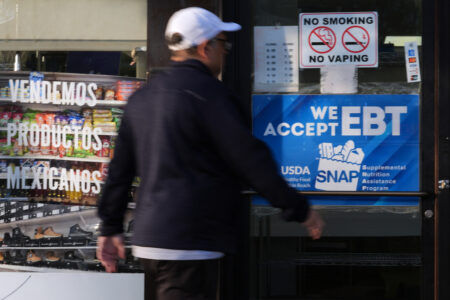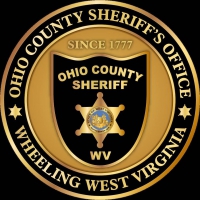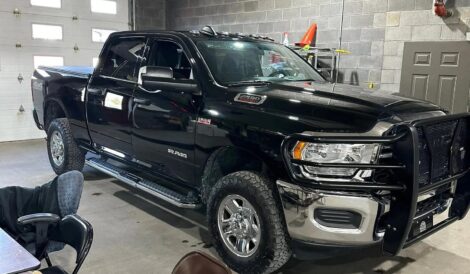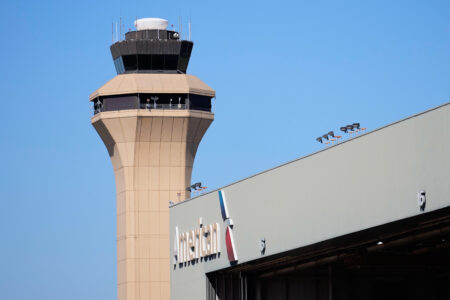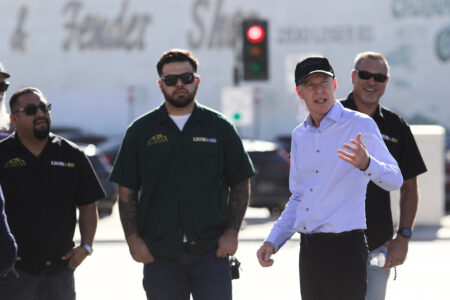McColloch’s Leap Monument To Be Restored, Relocated
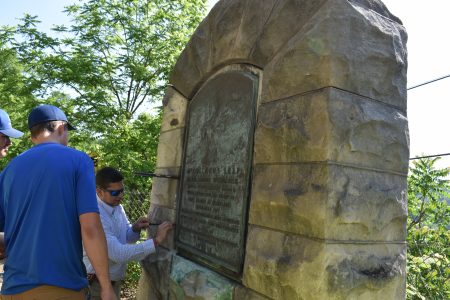
photo by: Photo by Eric Ayres
Jason Weiss of Boswell Monuments and crew members worked for well over an hour Friday chiseling and prying around the bronze plaque on the McColloch's Leap Monument atop Wheeling Hill. The bronze tablet, installed in 1917, was eventually removed and will be cleaned and restored before being put back in place later this year on a new granite monument at a more visible and accessible site on the hillside at the intersection across from the Mingo Indian statue.
WHEELING — An historic monument for one of the Wheeling area’s most celebrated pioneers will soon have a fresh new look — and a new and improved home.
The McColloch’s Leap Monument atop Wheeling Hill is currently undergoing an ambitious restoration. The monument was placed at the hilltop site at the crest of National Road back in 1917 by the West Virginia Chapter of the Daughters of the Revolution of 1775.
The placement of the sandstone monument and embossed bronze plaque was held to commemorate the 140th anniversary year of Major Samuel McColloch’s daring feat of bravery.
As stated on the tablet, McColloch was a “daring scout” and “gallant soldier” who in September 1777 — while attempting the relief of Fort Henry in Wheeling — escaped an overwhelming body of Native American fighters “by forcing his horse over this precipice.”
McColloch’s Leap has since been solidified in local lore as one of the most valiant Wheeling-area events of the Revolutionary War era, rivaled only by Betty Zane’s legendary gunpowder run.
The monument itself has seen better days over the past century. National Road has been widened since the monument was placed at the site in 1917, and before Interstate 70 was completed in 1966, that section of roadway was made to accommodate commercial carriers and highway traffic.
Jay Frey, president of the Fort Henry Chapter of the National Society of the Sons of the American Revolution, said the monument was much more accessible before National Road was widened. With its lack of visibility and continued deterioration, the monument was in need of a new chapter in history, which led the SAR Chapter members to leap into action.
“This is our signature project for the forthcoming 250th anniversary of America’s independence in 2026,” Frey said on Friday, when crews from Boswell Monuments and the city of Wheeling gathered at the site for the removal of the bronze plaque — and the start of the official restoration.
“McColloch survived the leap, but I don’t know if the monument would survive a collapse,” Frey said, noting that the sidewalks on Wheeling Hill and the cantilevered supports along the hillside are deteriorating, as is the sandstone monument that holds the plaque itself. “We’ve raised more than $30,000 so far. Our lead donor to the project is the Rotary Club of Wheeling.”
Frey said the Rotary Club donated $12,000 toward the restoration project, and the Fort Henry Chapter of the SAR has received more than $20,000 in gifts and grants. Fundraising efforts for the restoration project are ongoing, Frey noted.
Boswell Monuments, the local Rock of Ages agency, has already been working on a new granite monument to hold the bronze tablet in place once it is cleaned.
“It’s going to be fully restored to its original look,” said Jason Weiss, sales manager at Boswell Monuments. “The granite is in production right now.”
Sandstone from the existing monument will also be disassembled, salvaged and repurposed around the new monument site, which will be across the street from the current location. Frey said thanks to a generous donation by Wheeling residents Ray and Dina Carney, a more visible and accessible site for the monument will be placed nearby on a vacant piece of property at the intersection of Mt. Wood Road, Pike Street and National Road.
“The monument hasn’t had any type of restoration performed on it during its history,” Frey said, explaining that the mortar between some of the sandstone blocks on the monument has deteriorated away over the past 105 years since being placed on the hill, and the face of the plaque is nearly illegible. “The bronze tablet will be restored and waterproofed.”
Frey added that the city of Wheeling will be completing a sidewalk restoration project this year on Wheeling Hill. An ADA-compliant site plan is being prepared by Gabe Hays, director of Landscape Architecture and Planting at Wallace Pancher Inc. of St. Clairsville.
McColloch’s story isn’t all triumphant, Frey noted. Although he and his horse escaped the group and survived the lead (or more accurately, a “slide” down the steep hillside above Wheeling Creek), he was killed by hostile Native Americans just a few years afterward. He was not only scalped, but was reportedly dismembered. Because he was revered by even his enemies for his heroic and brave actions, historic accounts state that his pursuers ate his heart with the belief that his bravery would be conveyed to them, Frey shared.
Although many local people associate McColloch’s Leap with the Mingo Statue atop Wheeling Hill above Fulton, the monument is a different landmark that predates the famous and iconic local statue. The statue, depicting a member of the Mingo tribe with one outstretched arm, was installed by the Wheeling Kiwanis Club in 1928 has a plaque with an inscription that states that “the Mingo” were an “original inhabitant of this valley” who “extends greetings and peace to all wayfarers.”
The Mingo statue, although subject to vandalism over the decades, is a widely recognized landmark in Wheeling that has been well maintained over the years and was recently restored. The new McColloch’s Leap Monument will be moved closer to the statue at the same hilltop intersection.

